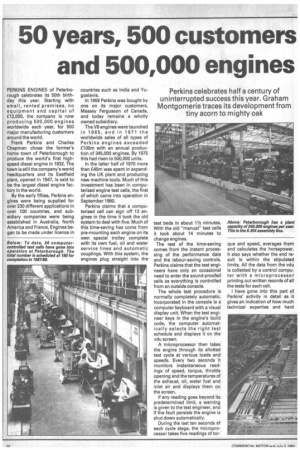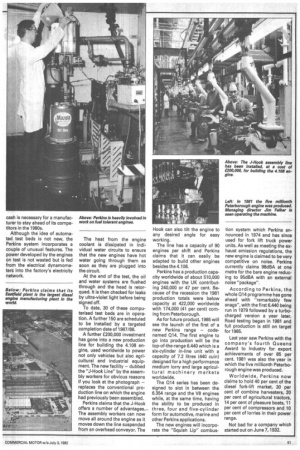50 years, 500 customers and 500,000 engines
Page 38

Page 39

If you've noticed an error in this article please click here to report it so we can fix it.
PERKINS ENGINES of Peterborough celebrates its 50th birthday this year. Starting with small, rented premises, no equipment and capital of £12,000, the company is now producing 500,000 engines worldwide each year, for 500 major manufacturing customers around the world.
Frank Perkins and Charles Chapman chose the formers home town of Peterborough to produce the world's first highspeed diesel engine in 1932. The town is still the company's world headquarters and its Eastfield plant, opened in 1947, is said to be the largest diesel engine factory in the world.
By the early fifties, Perkins engines were being supplied for over 230 different applications in over 100 countries, and subsidiary companies were being established in Australia, North America and France. Engines began to be made under licence in countries such as India and Yugoslavia.
In 1959 Perkins was bought by one on its major customers, Massey Fergusson of Canada, and today remains a wholly owned subsidiary.
The V8 engines were launched in 1965, and in 1971 the worldwide sales of all types of Perkins engines exceeded f100m with an annual production of 345,000 engines. By 1975 this had risen to 500,000 units.
In the latter half of 1970 more than £40m was spent in expanding the UK plant and producing new machine tools. Much of this investment has been in computerised engine test cells, the first of which came into operation in September 1980.
Perkins claims that a computerised cell can sign off 13 engines in the time it took the old system to deal with five. Much of this time-saving has come from pre-mounting each engine on its own special trolley complete with its own fuel, oil and water service lines and automatic couplings. With this system, the engines plug straight into the
test beds in about 11/2 minutes. With the old "manual" test cells it took about 14 minutes to change engines.
The rest of the time-saving comes from the instant processing of the performance data and the labour-saving controls. Perkins claims that the test engineers have only an occasional need to enter the sound-proofed cells as everything is controlled from an outside console.
The whole test procedure is normally completely automatic. Incorporated in the console is a computer keyboard with a visual display unit. When the test engineer keys in the engine's build code, the computer automatically selects the right test schedule and displays it on the vdu screen.
A microprocessor then takes the engine through its allotted test cycle at various loads and speeds. Every two seconds it monitors instantaneous readings of speed, torque, throttle opening and the temperatures of the exhaust, oil, water fuel and inlet air and displays them on the screen.
If any reading goes beyond its predetermined limit, a warning is given to the test engineer, and if the fault persists the engine is shut down automatically.
During the last ten seconds e each cycle stage, the microprocessor takes five readings of tor-.
que and speed,. averages them and calculates the horsepower. It also says whether the end result is within the stipulated limits. All the data from the vdu is collected by a control compute r with a microprocessor printing out written records of all the tests for each cell.
have gone into this part of Perkins' activity in detail as it gives an indication of how much technical expertise and hard cash is necessary for a manufacturer to stay ahead of its competitors in the 1980s.
Although the idea of automated test beds is not new, the Perkins system incorporates a couple of unusual features. The power developed by the engines on test is not wasted but is fed from the electrical dynamometers into the factory's electricity network.
The heat from the engine coolant is dissipated in individual water circuits to ensure that the new engines have hot water going through them as soon as they are plugged into the circuit.
At the end of the test, the oil and water systems are flushed through and the head is retorqued. It is then checked for leaks by ultra-violet light before being signed off.
To date, 30 of these computerised test beds are in operation. A further 150 are scheduled to be installed by a targeted completion date of 1987/88.
A further £200,000 investment has gone into a new production line for building the 4.108 engine, used worldwide to power not only vehicles but also agricultural and industrial equipment. The new facility – dubbed the "J-Hook Line" by the assembly workers for obvious reasons if you look at the photograph – replaces the conventional production line on which the engine had previously been assembled.
Perkins claims that the J-Hook offers a number of advantages— The assembly workers can now move all around the engine as it moves down the line suspended from an overhead conveyor. The Hook can also tilt the engine to any desired angle for easy working.
The line has a capacity of 90 engines per shift and Perkins claims that it can easily be adapted to build other engines besides the 4.108.
Perkins has a production capacity worldwide of about 510,000 engines with the UK contributing 240,000 or 47 per cent. Because of the recession the 1981 production totals were below capacity at 422,000 worldwide with 174,000 (41 per cent) coming from Peterborough.
As for future product, 1985 will see the launch of the first of a new Perkins range – codenamed 014. The first engine to go into production will be the top-of-the-range 6.440 which is a six-cylinder in-line unit with a capacity of 7.2 litres (440 cuin) designed for a high performance medium lorry and large agricultural machinery markets worldwide.
The 014 series has been designed to slot in between the 6.354 range and the V8 engines while, at the same time, having the ability to be produced in three, four and five-cylinder form for automotive, marine and other Perkins applications.
The new engines will incorporate the "Squish Lip" combus tion system which Perkins announced in 1974 and has since used for fork lift truck power units. As well as meeting the exhaust emission regulations, the new engine is claimed to be very competitive on noise. Perkins currently claims 98dBA at one metre for the bare engine reducing to 95dBA with an external noise "package".
According to Perkins, the whole 014 programme has gone ahead with "remarkably few snags", with the first 6.440 being run in 1979 followed by a turbocharged version a year later. Road testing began in 1981 and full production is still on target for 1985.
Last year saw Perkins with the company's fourth Queens Award to Industry for export achievements of over 85 per cent. 1981 was also the year in which the five millionth Peterborough engine was produced.
Worldwide, Perkins now claims to hold 40 per cent of the diesel fork-lift market, 30 per cent of combine harvesters, 20 per cent of agricultural tractors, 14 per cent of pleasure boats, 11 per cent of compressors and 10 per cent of lorries in their power range.
Not bad for a company which started out on June 7, 1932.








































